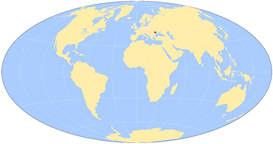 Greetings!
Greetings!
The area through which I travelled in this travelogue is in the news again today. It seems that the Russian areas of Ukraine are in rebellion with possible talk of cessation and the involvement of Russian troops. But all that is not so new and for the policymakers and commentators of Kiev and Moscow could do worse than head to their little neighbour Moldova. Last week we looked at Gagauzia, the area that wanted to secede but didn’t and next week we’ll be heading to Transdniestra, the Russian-speaking region of Moldova that went one step further. But for today, let’s head to the capital, the Moldova Kiev, the beating heart of a Moldovan nationalism that gave so much pride to some of its citizens but so scared some of the others. Those who forget the lessons of history are condemned to repeat the same mistakes and so, once again, please, Kiev, heed the lesson of Moldova!
Keep travelling!
Uncle Travelling Matt
Links to all parts of the travelogue:
Ukraine
Moldova and Transdniestra
Romania
3.4: The Painted Monasteries of Bucovina
3.5: Targu Neamt, Agapia and Sihla
3.7: The Mocanita and Viseu de Sus
3.8: Viseu de Sus to Bucharest
Chişinău (I)
If the outskirts of Chișinău that I’d passed through in the taxi had been a little different to expectations, then the Hotel Cosmos was a complete surprise. I’d chosen the establishment on one basis alone, the same factor that determines all my hotel choices: cost. I go for cheap, not nice and so rarely do I actually expect my hotels to be any good. And at twenty-storeys high with a hundred and fifty room, I’d expected the Cosmos to be naught more than an impersonal sleeping factory. However, when I arrived there the staff were not just professional – not always a guaranteed in that part of the world – they were friendly and it felt more like I was checking into a homely B&B in Llandudno to which one returns year after year than the former Inturist monolith in the state capital.
Yet part of the Cosmos’ charm was also its Inturist credentials. It had evidently been built in the 1960s as Chișinău’s top hotel: luxury, state-of-the-art, where diplomats and commissars stayed. It was so retro, it was gorgeous, the kind of establishment that James Bond when he was Sean Connery would have stayed in. If only I’d had a dapper Anthony Sinclair suit, (with a Walther PPK hidden in the jacket), a cigarette and a trilby, and I’m sure that as I stepped out a hot chick in an Aston convertible would have swung in to pick me up, closely followed by a couple of cars with blacked-out windows full of gangsters or Soviet spies taking pot-shots at Miss Moneypennescu, (she would be Moldovan after all), and I.
Not that Chișinău is short of gangsters, (more than a few of whom were no doubt once upon a time Soviet spies), cars with blacked-out windows, guns or hot chicks. After checking in I embarked on a walking tour of the centre and saw all of them in abundance, (except the guns which were, after all, hidden in either the blacked-out cars, jackets of the gangsters or handbags of the chicks). It was immediately apparent that this was no normal city, or at least, not one with a normal economy. It was a place of wealth symbolised by the enormous new shopping centre and casino next to my hotel and by the swanky and sophisticated restaurant in which I dined, (lunchtime special 120 lei - $10), next to grinding poverty represented by everything else.. The cars were either brand-new Mercedes-Benzes or BMWs, or decades-old Ladas or Moskviches, whilst every other shop was a bureau de change. In Chișinău it seems, there’s lots of money to change but very little to spend it on.
Whilst Tony Hawk’s had been technically correct about Chișinău being a typical grey and bland Soviet city, (it was completely rebuilt after the war after being subjected to an earthquake in 1940 and heavy bombardments afterwards), I think he was too harsh. Chișinău has a charm to it, I can’t quite put my finger on what exactly, but there is something. My guidebook described it as cosiness but to be honest, I’m not sure that that is the right word.
I wandered along the busy highway of Str. Albişoara and then up B-dul Renaşterii. Whilst Romanian – of Moldovan if you prefer – is clearly the main language here, (and thus I found myself in a zone of incomprehension for the first time on this trip), Russian is still quite prominent on both the signs and the tongues of the locals. Still, that doesn’t seem to be enough for some folk; on the pavement of B-dul Renaşterii some angry citizen had spray-painted a sword sticking into an unhappy face with the legend ‘РУМЫН’ (Romanians) whilst the sword itself was labelled ‘RUSSIA’. No further explanation is needed.
I walked up to the Parcul Catedralei, a large green space with the Orthodox Cathedral plonked in the middle. Inside there was a Mass in progress and I stayed to listen to the beautiful liturgy before exiting to investigate the nearby Triumphal Arch around which a chap in a bear suit was milling, trying to entice passers-by to have a photo take with him for a few lei.
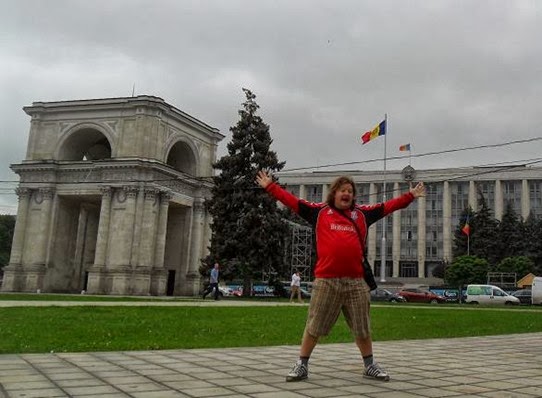 Chișinău Cathedral, Triumphal Arch and House of the Soviet
Chișinău Cathedral, Triumphal Arch and House of the Soviet
I checked out and photographed Chișinău’s other sights – the Government House, the Grădina Publică Ștefan cel Mare și Sfânt with its statue of Ştefan cel Mare on the corner, the Parliament House and the Presidential Palace.
Ştefan cel Mare (Stephen the Great) was a name that I was to see everywhere both in Moldova and across the border in the Romanian province of Moldavia. He’s the martial national hero of the mould that seems to crop up in most tiny nations. As the Prince of Moldavia, a mediaeval kingdom that encompassed both the Republic of Moldova and Romanian Moldavia, he defended his lands against Poland, Hungary but most famously, the Ottomans. In his long career he only ever lost two battles and as a result of his holding back the heathens from Europe for so long, Pope Sixtus IV awarded him the Atheta Christi (Champion of Christ) whilst the Orthodox Church went one further and declared him a saint, (despite the fact that he had fathered over twenty illegitimate children). And if all that were not enough, Ştefan has one other impressive claim to fame: Vlad Ţepeş – better known in the West as ‘Dracula’ – was his cousin.
 Ştefan cel Mare statue, Chișinău
Ştefan cel Mare statue, Chișinău
The Grădina Publică, Chișinău’s most famous park, is another pleasant green space in the heart of the city. It has a fountain in its centre and an avenue of busts of Romanian-language literary greats – I had head of none of them, but it was all rather pleasant nonetheless. Chișinău may be no competition for Rome, Paris or London as a tourist hotspot, but at the same time it is also far less pretentious and not burdened with awful eating and drinking establishments enthusiastically described as “contemporary” in the guidebooks. I at least, was happy.
I wandered back to the hotel along B-dul Ştefan cel Mare which has some fine Stalinist buildings lining its sides and stopped off at a bookshop to purchase a Romanian dictionary for my class – I have a steady stream of Romanian students and Romanian dictionaries are for some unknown reason, almost unobtainable back in Britain – as well as some cheesy Moldovan souvenirs and a guidebook to the country – there are none currently in print in the UK – that was so bad it was brilliant. Then I popped into an internet café to see what I was letting myself in for on the morrow when I headed to breakaway Transdniestria before returning to the Cosmos, chatting again to the friendly reception staff and then retiring to my room to wait with my Walther PPK under the pillow and my trilby on the side), for Miss Moneypennescu to show (she never did) passing the time by watching a Korean news channel[1] as the sun set slowly on the Moldovan capital.
Next part: Tiraspol and Bender
[1] One of the programmes was on the rise of K-Pop (Korean Pop Music) and how it is rapidly gaining in popularity across Asia. ‘Ho hum,’ thought I, ‘it may be popular in China and the Philippines, but songs in Korean will never break the European or American markets.’ Just over a month later the chunky Korean cheester PSY released ‘Gangnam Stayle’ which went viral on YouTube and shot to No. 1 in dozens of countries including the UK and most in Europe. By December 2012 it had become the first video to reach over a billion views on the internet making it by far the most watched music video of all time and the most successful song of 2012. How wrong was I?
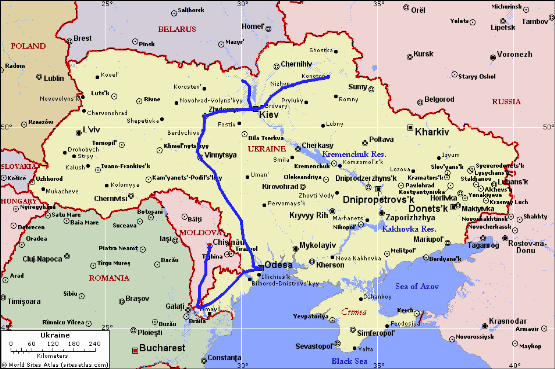
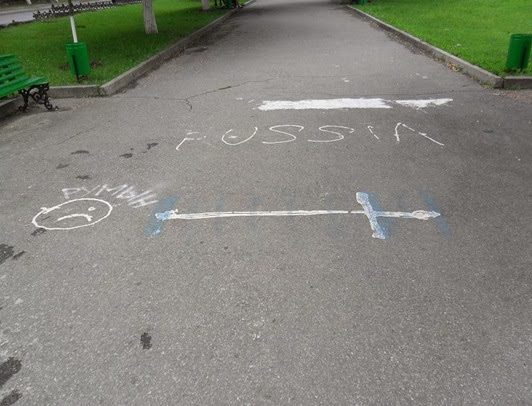
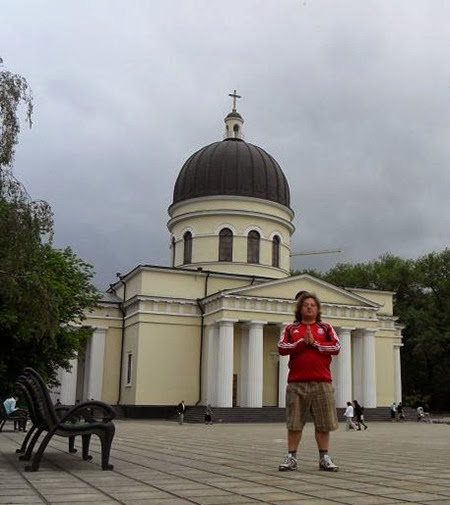
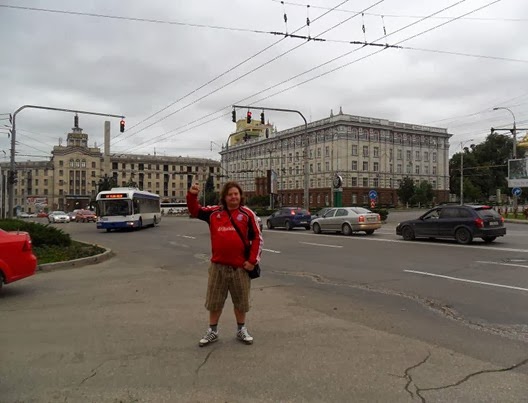
No comments:
Post a Comment